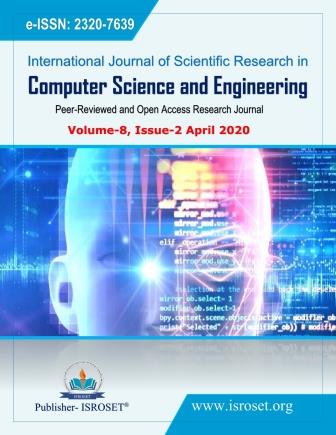A Deep Model for Meaning-aware Word Embedding
Keywords:
Deep Learning, Word Embedding, Word meaning, deep neural networks, Auto-encoders, Recursive auto-encodersAbstract
The context plays an important role in meaning construction and representation. Indeed, words are interpreted differently based on their contexts. Deep neural network have recorded recently a great success in representing the words’ meaning into one vector. Some researchers address the issue of different meaning of a word by constructing different vectors. However, the first category assumes a single state for each word while the second requires either meaning inventories or a preprocessing step to cluster contexts for each word. The latter ignores complicated correlations among words as well as their contexts. In this paper, we investigate another direction consists of representing the word meaning by an evolved vector over its set of context. To this end, we introduce a novel deep model that consists of using auto-encoders recursively based on left/right context around a target word. We evaluate our model on the semantic similarity task. Experimental results demonstrate that our deep model outperforms several competitive models that represent word meaning either with single vector or multiple vectors.
References
Z. Harris, “Distributional structure”, Word, Vol. 10, No. 23, pp. 146-162, 1954.
T. Mikolov, W.T. Yih, G. Zweig, “Linguistic regularities in continous space word representations”, NAACL’13, pp. 746-751, 2013.
J. Pennington, R. Socher, C. D. Manning, “Glove: Global vectors for word representation”, EMNLP, Vol. 14, pp. 1532-1543, 2014.
R. Socher, E.H. Huang, J. Pennin, C.D. Manning, A.Y. Ng, “Dynamic pooling and unfolding recursive autoencoders for paraphrase detection”, Advances in Neural Information Processing Systems, pp. 801-809, 2011.
R. Socher, A. Perelygin, J.Y. Wu, J. Chuang, C.D. Manning, A.Y. Ng, C. Potts, “Recursive deep models for semantic compositionality over a sentiment Treebank” , EMNLP, Vol. 1631, pp. 1631-1642, 2013.
R. Socher, K. Andrej, V.L. Quoc, D. M. Christopher, and Y Ng. Andrew, “Grounded compositional semantics for finding and describing images with sentences” , Transactions of the Association for Computational Linguistics, pp. 67-78, 2014.
S. Suriya1, K. Sindhu Meena, “A Novel Approach for Cloud Computing Sentimental Analysis of Twitter Using Long Short-Term Memory and Gate Recurrent Unit” , International Journal of Scientific Research in Computer Science and Engineering, Vol. 8, Issue.1, pp.1-6, 2020.
Y. Bengio, R. Ducharme, P. Vincent, C. Jauvin, “A neural probabilistic language model” , Journal of machine learning research, Vol. 3, pp. 1137-1155, 2003.
P. Bojanowski, E. Grave, A. Joulin, T. Mikolov, “Enriching word vectors with subword information” , Transactions of the Association for Computational Linguistics, Vol. 5, pp. 135-146, 2017.
J. Reisinger, R. J. Mooney, “Multi-prototype vector-space models of word meaning ” , Annual Conference of the North American Chapter of the Association for Computational Linguistics, pp. 109-117, 2010.
E. H. Huang, R. Socher, C. D. Manning, A. Y. Ng, “Improving word representations via global context and multiple word prototypes ” , In The 50th Annual Meeting of the Association for Computational Linguistics, Island, pp. 873-882, 2012.
A. Neelakantan, J. Shankar, A. Passos, A. McCallum, “Efficient non-parametric estimation of multiple embeddings per word in vector space” ,Conference on Empirical Methods in Natural Language, Doha, Qatar, pp. 1059-1069, 2015.
Y. Liu, Z. Liu, T. S. Chua, M. Sun, “Topical word embeddings”, AAAI Conference on Artificial Intelligence, Texas, pp. 2418-2424, 2015.
D. Q. Nguyen, D. Q. Nguyen, A. Modi, S. Thater, M. Pinkal, “A mixture model for learning multi-sense word embeddings”, SEM Association for Computational Linguistics, pp. 121-127, 2017.
D. P. Kingma and J. L. Ba, “Adam: a method for stochastic optimization”, International Conference on Learning Representations, pp. 1-13, 2015.
R. Corley, C. Mihalcea, “Measuring the semantic similarity of texts,” EMSSE, pp. 13-18, 2005.
R. Collobert, J. Weston, L. Bottou, M. Karlen, K. Kavukcuoglu, P. Kuksa, “Natural language processing (almost) from scratch”, Journal of Machine Learning Research, Vol. 12, pp. 2493-2537, 2011.
J. Li, D. Jurafsky, “Do multi-sense embeddings improve natural language understanding,” Empirical Methods in Natural Language, pp. 1722-1732, 2015.
Z. Liu, X. Chen, M. Sun, “A unified model for word sense representation and disambiguation” , EMNLP, pp. 1025-1035, 2014.
F. Guo, M. Iyyer, J. L. Boyd-Graber, “Inducing and embedding senses with scaled gumbel softmax” , ArXiv, pp. 1524-1536, 2018.
Downloads
Published
How to Cite
Issue
Section
License

This work is licensed under a Creative Commons Attribution 4.0 International License.
Authors contributing to this journal agree to publish their articles under the Creative Commons Attribution 4.0 International License, allowing third parties to share their work (copy, distribute, transmit) and to adapt it, under the condition that the authors are given credit and that in the event of reuse or distribution, the terms of this license are made clear.







